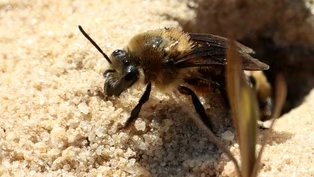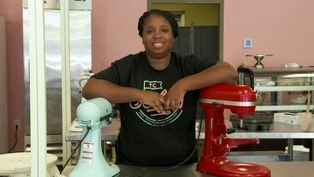
4-Headed Pindo Palm Found Hiding In Plain Sight
Clip: Season 10 Episode 1 | 5m 14sVideo has Closed Captions
A rare 4-headed pindo palm tree found hiding in plain sight at the WFSU Broadcast Center.
A rare 4-headed pindo palm tree is hiding in plain sight at the WFSU Broadcast Center in Tallahassee, FL. The multi-crowned palm was given the name Vincent back in 2012 when it was discovered to have 3 heads. Originally planted with a single head in the early 1980’s, Vincent just recently revealed it’s fourth head. WFSU Public Media’s Mike Plummer brings you the story.
Problems playing video? | Closed Captioning Feedback
Problems playing video? | Closed Captioning Feedback
Local Routes is a local public television program presented by WFSU

4-Headed Pindo Palm Found Hiding In Plain Sight
Clip: Season 10 Episode 1 | 5m 14sVideo has Closed Captions
A rare 4-headed pindo palm tree is hiding in plain sight at the WFSU Broadcast Center in Tallahassee, FL. The multi-crowned palm was given the name Vincent back in 2012 when it was discovered to have 3 heads. Originally planted with a single head in the early 1980’s, Vincent just recently revealed it’s fourth head. WFSU Public Media’s Mike Plummer brings you the story.
Problems playing video? | Closed Captioning Feedback
How to Watch Local Routes
Local Routes is available to stream on pbs.org and the free PBS App, available on iPhone, Apple TV, Android TV, Android smartphones, Amazon Fire TV, Amazon Fire Tablet, Roku, Samsung Smart TV, and Vizio.
Providing Support for PBS.org
Learn Moreabout PBS online sponsorshipstill the it is often said that two heads are better than one.
Will you please stop this infernal machine?
Oh, just shut up!
Help!
Shut up!
Now it's your turn.
In theory, maybe.
In Hollywood, not so much.
But in Florida, nature doesn't stop at two heads.
In 2012, we discovered a three headed pindo palm growing out in front of the WFSU Broadcast Center.
Our news department documented the discovery with an online write up, then named the palm, Vincent.
Also in Florida, Panama City claimed the world's only four headed pindo palm.
Locals called him for Toed Pete.
Go figure.
The four headed Panama City Pindo went roots up in 2018.
So imagine our surprise one recent morning when an alert camera shy employee blurted out, Hey, when did our palm tree grow.
Another head.
It was true.
Vincent, the three headed pindo palm was now sporting a new fourth set of palm fronds.
Naturally, I wanted answers so I went to the source, How long have you been here, Mr. Pindo?
Well, you say something.
but my queries went unanswered.
Vincent wasn't talking.
Undaunted, I dispatched a crackerjack research team to sift through the archives, and they hit silver, silver nitrate, that is.
A photo of young Vincent dating back to 1983.
That's him hiding behind the broadcast center sign.
Furthermore, he appeared to only have one head.
We now knew Vincent was at least 41 years old, and was originally a mono top.
One of the great advantages of working at a top research university is that we have access to smart people, unfazed by unusual questions.
I contacted David MacManus, assistant director of landscaping at Florida State University.
Where here we see these, two trunks develop.
Yep.
The central bud, was disturbed.
In some fashion.
And then two buds developed, growing and making these two heads, which then later, for some unknown reason, once again, we have them branching out so that we have four heads.
So now.
So we think that so this is first, then these two are second.
Right.
And this would be third.
Right.
Okay.
Which happened, you know, twice.
And then over here, this is one we just discovered.
Yes.
This, head here is younger than.
Or is it this one or this one?
This is the youngest.
Okay.
Here it's come out.
And this is the older one right here.
Okay.
Yeah.
Because we hadn't, we had...in 2012.
This was the three headed palm.
But now it's a four headed.
But now it's four had it.
So in the past 12 years somehow that happened and nobody noticed it until a couple days ago.
The pindo palm is widely planted here.
It's originally from, southern Brazil, northern Argentina, Paraguay and Uruguay in South America and its native habitat.
It's many times found in grasslands and and dry forest So the pindo palm relation to the other palms, and it's a slower growing palm and it's very, quite long lived.
And it's very likely that there are a number of specimens, you know, in South America that, you know, may be upwards to nearly 400 years old.
Oh, wow.
We're talking hundreds of years, not decades.
Right?
So do you have any idea what causes the pindo palm to grow multiple heads?
Anything that really disturbs that central, apical bud, causing it to bend or break, you know, can, then stimulate, the production then of more than one, apical bud.
And, this could be due to physical injury, for example, a limb falling on the bud, from wind, you know, breaking it.
It could be, due to conditions such as fire or an insect or animal chewing on it.
There's just a number of different reasons why it could make that response.
However, it's also true that such palms.
that once they do this, they many times will have a tendency to make, more heads.
But this one here at WFSU, I think is, a worthy destination for palm lovers.
If you want to see a really cool, multi-headed Pindo palm, you come here to WFSU and you'll see it.
Meanwhile, repeated efforts to communicate with Vincent have proven futile.
for WFSU Public Media, I'm Mike Plummer.
Finding the rare sandhills cellophane bee – with data
Video has Closed Captions
Clip: S10 Ep1 | 7m 13s | Researchers use citizen science data to find the rare sandhills cellophane bee. (7m 13s)
A Taste of Tallahassee's TC Bakery
Video has Closed Captions
Clip: S10 Ep1 | 11m 40s | Meet Jennifer Young, owner and baker of Tallahassee's TC Bakery. (11m 40s)
Providing Support for PBS.org
Learn Moreabout PBS online sponsorshipSupport for PBS provided by:
Local Routes is a local public television program presented by WFSU















